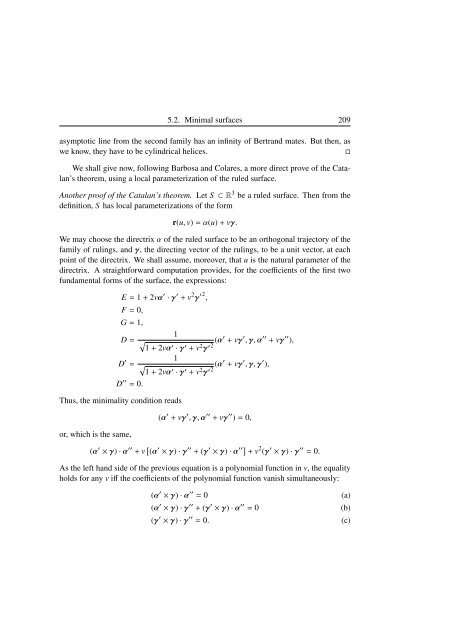Blaga P. Lectures on the differential geometry of - tiera.ru
Blaga P. Lectures on the differential geometry of - tiera.ru
Blaga P. Lectures on the differential geometry of - tiera.ru
Create successful ePaper yourself
Turn your PDF publications into a flip-book with our unique Google optimized e-Paper software.
5.2. Minimal surfaces 209<br />
asymptotic line from <strong>the</strong> sec<strong>on</strong>d family has an infinity <strong>of</strong> Bertrand mates. But <strong>the</strong>n, as<br />
we know, <strong>the</strong>y have to be cylindrical helices. �<br />
We shall give now, following Barbosa and Colares, a more direct prove <strong>of</strong> <strong>the</strong> Catalan’s<br />
<strong>the</strong>orem, using a local parameterizati<strong>on</strong> <strong>of</strong> <strong>the</strong> <strong>ru</strong>led surface.<br />
Ano<strong>the</strong>r pro<strong>of</strong> <strong>of</strong> <strong>the</strong> Catalan’s <strong>the</strong>orem. Let S ⊂ R 3 be a <strong>ru</strong>led surface. Then from <strong>the</strong><br />
definiti<strong>on</strong>, S has local parameterizati<strong>on</strong>s <strong>of</strong> <strong>the</strong> form<br />
r(u, v) = α(u) + vγ.<br />
We may choose <strong>the</strong> directrix α <strong>of</strong> <strong>the</strong> <strong>ru</strong>led surface to be an orthog<strong>on</strong>al trajectory <strong>of</strong> <strong>the</strong><br />
family <strong>of</strong> <strong>ru</strong>lings, and γ, <strong>the</strong> directing vector <strong>of</strong> <strong>the</strong> <strong>ru</strong>lings, to be a unit vector, at each<br />
point <strong>of</strong> <strong>the</strong> directrix. We shall assume, moreover, that u is <strong>the</strong> natural parameter <strong>of</strong> <strong>the</strong><br />
directrix. A straightforward computati<strong>on</strong> provides, for <strong>the</strong> coefficients <strong>of</strong> <strong>the</strong> first two<br />
fundamental forms <strong>of</strong> <strong>the</strong> surface, <strong>the</strong> expressi<strong>on</strong>s:<br />
E = 1 + 2vα ′ · γ ′ + v 2 γ ′2 ,<br />
F = 0,<br />
G = 1,<br />
1<br />
D = �<br />
1 + 2vα ′ · γ ′ + v2γ ′2 (α′ + vγ ′ , γ, α ′′ + vγ ′′ ),<br />
D ′ =<br />
D ′′ = 0.<br />
Thus, <strong>the</strong> minimality c<strong>on</strong>diti<strong>on</strong> reads<br />
or, which is <strong>the</strong> same,<br />
1<br />
� 1 + 2vα ′ · γ ′ + v 2 γ ′2 (α′ + vγ ′ , γ, γ ′ ),<br />
(α ′ + vγ ′ , γ, α ′′ + vγ ′′ ) = 0,<br />
(α ′ × γ) · α ′′ + v � (α ′ × γ) · γ ′′ + (γ ′ × γ) · α ′′� + v 2 (γ ′ × γ) · γ ′′ = 0.<br />
As <strong>the</strong> left hand side <strong>of</strong> <strong>the</strong> previous equati<strong>on</strong> is a polynomial functi<strong>on</strong> in v, <strong>the</strong> equality<br />
holds for any v iff <strong>the</strong> coefficients <strong>of</strong> <strong>the</strong> polynomial functi<strong>on</strong> vanish simultaneously:<br />
(α ′ × γ) · α ′′ = 0 (a)<br />
(α ′ × γ) · γ ′′ + (γ ′ × γ) · α ′′ = 0 (b)<br />
(γ ′ × γ) · γ ′′ = 0. (c)












